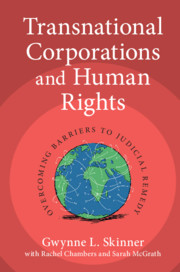Book contents
- Transnational Corporations and Human Rights
- Transnational Corporations and Human Rights
- Copyright page
- Dedication
- Dedication
- Contents
- Foreword
- Abbreviations
- Table of Cases
- Table of Statutes
- Introduction
- Part I Rise of Transnational Corporations, Impact on Human Rights, And Victims’ Rights to Remedy
- 1 Growth and Structure of TNCs
- 2 Victims’ Rights To Remedy for Business-Related Human Rights Violations
- 3 Barriers to Judicial Remedies in Host Countries
- 4 Limits on Subject Matter Jurisdiction over International Human Rights Violations
- 5 Limited Liability of Parent Corporations
- 6 Lack of In Personam Jurisdiction over TNCs and their Affiliates
- Part II Legal Barriers to Remedy and How to Overcome Them
- Conclusion
- Select Bibliography
- Index
1 - Growth and Structure of TNCs
from Part I - Rise of Transnational Corporations, Impact on Human Rights, And Victims’ Rights to Remedy
Published online by Cambridge University Press: 04 September 2020
- Transnational Corporations and Human Rights
- Transnational Corporations and Human Rights
- Copyright page
- Dedication
- Dedication
- Contents
- Foreword
- Abbreviations
- Table of Cases
- Table of Statutes
- Introduction
- Part I Rise of Transnational Corporations, Impact on Human Rights, And Victims’ Rights to Remedy
- 1 Growth and Structure of TNCs
- 2 Victims’ Rights To Remedy for Business-Related Human Rights Violations
- 3 Barriers to Judicial Remedies in Host Countries
- 4 Limits on Subject Matter Jurisdiction over International Human Rights Violations
- 5 Limited Liability of Parent Corporations
- 6 Lack of In Personam Jurisdiction over TNCs and their Affiliates
- Part II Legal Barriers to Remedy and How to Overcome Them
- Conclusion
- Select Bibliography
- Index
Summary
A description of the varied types of complex business structures employed by large, transnational businesses is outside the scope of this book. However, a few key facts about corporate growth and structure are important to note, given the current jurisdictional paradigm’s focus on the “home” (or in Europe, domicile) of a corporation – a paradigm that is based on outdated notions of how TNCs are structured. First, the sheer growth in number of TNCs has changed the operation of business and the resultant potential for human rights violations at the global scale. The number of TNCs – including parent companies and subsidiaries – has grown exponentially over the last fifty years. Moreover, as companies grow in size and expand overseas, the number of subsidiaries tends to increase and companies’ structures become even more complex.1 Over the last several decades, as TNCs have grown and created other corporations, they have rapidly changed form, with the emergence of complex multi-tiered corporate structures which include numerous affiliated entities that collectively conduct the business of the enterprise.2 As a result, it is difficult to determine ownership of TNCs’ various affiliated companies or to compile complete financial data on TNCs due to their complex structure, the existence of holding companies, and the fact that a subsidiary can be owned by multiple parent corporations.3 Lack of transparency surrounding ownership and existence of various TNC affiliates only exacerbates the problem.
- Type
- Chapter
- Information
- Transnational Corporations and Human RightsOvercoming Barriers to Judicial Remedy, pp. 9 - 13Publisher: Cambridge University PressPrint publication year: 2020



